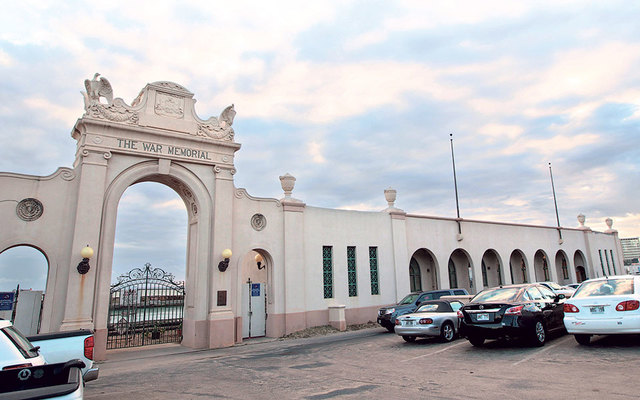Restored Waikiki Natatorium envisioned by Nov. 11, 2019
The Waikiki Natatorium War Memorial could be restored to its former glory — but with a high-tech touch — by 2019, exactly 100 years after the land was first acquired to construct the site, according to the senior field officer and attorney for the National Trust for Historic Preservation.
Honolulu’s Department of Design and Construction hosted a series of meetings over four days last week with nearly 60 interested groups to gather information on the historic aspect of the natatorium’s design and the upcoming environmental impact study.
The ocean-water public swimming pool, where local Olympic gold medalist Duke Kahanamoku swam, was built as a memorial to those who served in World War I. Owned but not operated by the state, the site was closed to the public in 1979 due to a lack of upkeep.
Brian Turner, a lawyer with the trust, said the site would be a “waste to lose,” and remains optimistic that the pool can be reopened within three years.
“We feel like we’ve developed a fresh look at something that’s been a real engineering puzzle,” Turner said. His goal is to have the project completed by the centennial of the armistice, Nov. 11, 2019.
For years there have been discussions on the memorial’s future — whether to demolish it, restore it completely or get rid of the pool but keep the facade. The National Trust for Historic Preservation, which placed the natatorium on its 11 most endangered structures list in 1995, submitted a proposal with preliminary drawings to rehabilitate the site, preserving as much of its original look as possible.
“We want it to be saved as much as possible, and most importantly, we don’t want it to cost too much,” Turner said, adding that the original $70 million price tag to restore the site is “just not acceptable.”
The trust’s design concept involves hollowing out the walls on the sides to allow the pool water to mix with the ocean.
A series of concrete walls called chevrons would be placed along the makai side, forcing waves to break before entering the structure. That would keep the pool surface calm and protect the bleachers.
There would be no effect on adjacent Kaimana Beach, he said.
“It would basically look the same, but it would have really updated, 21st-century engineering,” Turner said.
Hawaii-based engineers Hans Krock and Alfred Yee are principally responsible for the design concept, and Turner said they “know how to cut costs.” He said he hopes the meeting will “encourage the city to invest further in the concept.”
Robert Kroning, director of the city Department of Design and Construction, said there are a lot of differing opinions on the natatorium’s future and a lot of obstacles standing in the way, making Turner’s timeline “extremely optimistic.”
“The National Trust has presented drawings that show an open-type-system pool, but there hasn’t been any engineering or testing done,” Kroning said. “It’s all very premature.”
Kroning said the “historical aspect is just one piece” and that an environmental impact study must be conducted to determine the environmental, social and economic impacts of the site’s restoration. The EIS itself is an extensive process that, according to Kroning, would not see completion until 2018 at the earliest. Tests also must be done to make sure the pool meets all health and safety standards.
“Even if that happens, what will happen next is the determination to go forward or not,” Kroning said. “Then we gotta get the money, bring on designers and get the place ready for a contractor.”
He emphasized that during last week’s meetings nothing “was designed or determined in terms of an actual construction project.”
The trust will meet with the city in late August and again in October to determine what the city has learned before starting the environmental impact study. Turner acknowledged that the project is “procedurally very difficult,” but expressed confidence the city and members of the community will support their efforts.
“Right now we have something that it looks like everybody can get on board with,” Turner said. “We know it’s a real hot-button issue, but it’s not just a pool, it’s a public space.”


